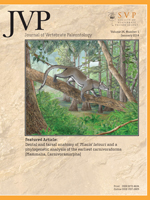One of the earliest basal carnivoraforms, Miacis latouri, previously known by only two teeth from the earliest Eocene of Dormaal, Belgium, is here described based on about 280 new specimens from Dormaal, allowing illustration of almost the entire deciduous and permanent dentition and thus giving information on the dentition of an early basal carnivoraform species and its variability. Based on the dental features, we refer the species to a new genus, Dormaalocyon. We identify possible sexual dimorphism in D. latouri that is less pronounced than in Uintacyon rudis. We also describe for the first time the tarsal bones (calcaneum and astragalus) of D. latouri; these indicate arboreal capabilities for this species. In order to ascertain the position of Dormaalocyon among basal carnivoraforms, we performed a phylogenetic analysis of the carnivoramorphans. Among basal carnivoraforms, three groups are recovered: the Uintacyon group, Oodectes group, and the Vulpavus group. Dormalocyon is one of the most primitive carnivoraforms and is closely related to North American Vulpavus and Miacis species. We propose that the two latter genera are North American with an ancestry that involves the European Dormaalocyon; this implies a dispersal of carnivoraforms from Europe to North America near the Paleocene-Eocene boundary. Finally, the topology of the phylogenetic tree supports a Paleocene radiation of the carnivoraforms, which is presently unknown.
How to translate text using browser tools
1 January 2014
Dental and Tarsal Anatomy of ‘Miacis’ latouri and a Phylogenetic Analysis of the Earliest Carnivoraforms (Mammalia, Carnivoramorpha)
Floréal Solé,
Richard Smith,
Tiphaine Coillot,
Eric De Bast,
Thierry Smith
ACCESS THE FULL ARTICLE





